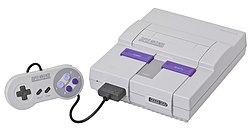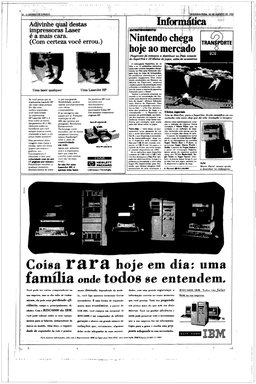Super Nintendo Entertainment System

Super Nintendo Entertainment System

 | |
Top: North American SNES (c. 1991) Bottom: PAL SNES, Japanese Super Famicom. Other variations are pictured under Casing below | |
| Also known as | SNES Super NES Super Nintendo |
|---|---|
| Developer | Nintendo R&D2 |
| Manufacturer | Nintendo |
| Type | Home video game console |
| Generation | Fourth generation |
| Release date | |
| Lifespan | 1990–2003[14] |
| Introductory price | ¥25,000 US$199 |
| Discontinued | |
| Units sold | Worldwide: 49.10 million[14] North America 23.35 million Japan: 17.17 million Other: 8.58 million |
| Media | ROM cartridge |
| CPU | Ricoh 5A22 @ 3.58 MHz |
| Sound | Nintendo S-SMP |
| Online services | Satellaview (Japan only) XBAND (USA and Canada only) Nintendo Power (Japan only) |
| Best-selling game | |
| Predecessor | Nintendo Entertainment System |
| Successor | Nintendo 64 |
| CPU reference | |
| Processor | 16-bit Custom WDC 65C816 core |
| Clock rates (NTSC) | Input: 21.47727 MHz Bus: 3.58 MHz, 2.68 MHz, or 1.79 MHz |
| Clock rates (PAL) | Input: 21.28137 MHz Bus: 3.55 MHz, 2.66 MHz, or 1.77 MHz |
| Buses | 24-bit and 8-bit address buses, 8-bit data bus |
| Additional features |
|
| Video reference | |
| Resolutions | Progressive: 256×224 (8:7), 512×224 (16:7), 256×239 (256:239), 512×239 (512:239) Interlaced: 512×448 (8:7), 512×478 (256:239) |
| Pixel depth | 2, 4, 7, or 8 bpp indexed; 8 or 11 bpp direct |
| Total colors | 32768 (15-bit) |
| Sprites | 128, 32 max per line; up to 64 × 64 pixels |
| Backgrounds | Up to 4 planes; each up to 1024 × 1024 pixels |
| Effects |
|
| Audio reference | |
| Processors | Nintendo S-SMP |
| Clock rates | Input: 24.576 MHz SPC700: 1.024 MHz |
| Output | 8 channels, stereo |
| Effects |
|
The Super Nintendo Entertainment System (SNES),[2] also known as the Super NES[3] or Super Nintendo,[4] is a 16-bit home video game console developed by Nintendo that was released in 1990 in Japan and South Korea, 1991 in North America, 1992 in Europe and Australasia (Oceania), and 1993 in South America. In Japan, the system is called the Super Famicom (SFC).[5] In South Korea, it is known as the Super Comboy[6] and was distributed by Hyundai Electronics. The system was released in Brazil on August 30, 1993,[26] by Playtronic. Although each version is essentially the same, several forms of regional lockout prevent the different versions from being compatible with one another.
The SNES is Nintendo's second programmable home console, following the Nintendo Entertainment System (NES). The console introduced advanced graphics and sound capabilities compared with other systems at the time. The system was designed to accommodate the ongoing development of a variety of enhancement chips integrated in game cartridges to be competitive into the next generation.
The SNES was a global success, becoming the best-selling console of the 16-bit era after launching relatively late and facing intense competition from Sega's Genesis console in North America and Europe. Overlapping the NES's 61.9 million unit sales, the SNES remained popular well into the 32-bit era, with 49.1 million units sold worldwide by the time it was discontinued in 2003. It continues to be popular among collectors and retro gamers, with new homebrew games and Nintendo's emulated rereleases, such as on the Virtual Console, the Super NES Classic Edition, and Nintendo Switch Online.
 | |
Top: North American SNES (c. 1991) Bottom: PAL SNES, Japanese Super Famicom. Other variations are pictured under Casing below | |
| Also known as | SNES Super NES Super Nintendo |
|---|---|
| Developer | Nintendo R&D2 |
| Manufacturer | Nintendo |
| Type | Home video game console |
| Generation | Fourth generation |
| Release date | |
| Lifespan | 1990–2003[14] |
| Introductory price | ¥25,000 US$199 |
| Discontinued | |
| Units sold | Worldwide: 49.10 million[14] North America 23.35 million Japan: 17.17 million Other: 8.58 million |
| Media | ROM cartridge |
| CPU | Ricoh 5A22 @ 3.58 MHz |
| Sound | Nintendo S-SMP |
| Online services | Satellaview (Japan only) XBAND (USA and Canada only) Nintendo Power (Japan only) |
| Best-selling game | |
| Predecessor | Nintendo Entertainment System |
| Successor | Nintendo 64 |
| CPU reference | |
| Processor | 16-bit Custom WDC 65C816 core |
| Clock rates (NTSC) | Input: 21.47727 MHz Bus: 3.58 MHz, 2.68 MHz, or 1.79 MHz |
| Clock rates (PAL) | Input: 21.28137 MHz Bus: 3.55 MHz, 2.66 MHz, or 1.77 MHz |
| Buses | 24-bit and 8-bit address buses, 8-bit data bus |
| Additional features |
|
| Video reference | |
| Resolutions | Progressive: 256×224 (8:7), 512×224 (16:7), 256×239 (256:239), 512×239 (512:239) Interlaced: 512×448 (8:7), 512×478 (256:239) |
| Pixel depth | 2, 4, 7, or 8 bpp indexed; 8 or 11 bpp direct |
| Total colors | 32768 (15-bit) |
| Sprites | 128, 32 max per line; up to 64 × 64 pixels |
| Backgrounds | Up to 4 planes; each up to 1024 × 1024 pixels |
| Effects |
|
| Audio reference | |
| Processors | Nintendo S-SMP |
| Clock rates | Input: 24.576 MHz SPC700: 1.024 MHz |
| Output | 8 channels, stereo |
| Effects |
|
History

Early concept designs for the SNES, referred to as the "Nintendo Entertainment System 2"
To compete with the popular Family Computer in Japan, NEC Home Electronics launched the PC Engine in 1987, and Sega followed suit with the Mega Drive in 1988. The two platforms were later launched in North America in 1989 as the TurboGrafx-16 and the Sega Genesis respectively. Both systems were built on 16-bit architectures and offered improved graphics and sound over the 8-bit NES. However, it took several years for Sega's system to become successful.[27] Nintendo executives were in no rush to design a new system, but they reconsidered when they began to see their dominance in the market slipping.[28]
Launch
Designed by Masayuki Uemura, the designer of the original Famicom, the Super Famicom was released in Japan on Wednesday, November 21, 1990 for ¥25,000 (equivalent to 27,800 yen in 2019). It was an instant success; Nintendo's initial shipment of 300,000 units sold out within hours, and the resulting social disturbance led the Japanese government to ask video game manufacturers to schedule future console releases on weekends.[29] The system's release also gained the attention of the Yakuza, leading to a decision to ship the devices at night to avoid robbery.[30]
Nintendo released the Super Nintendo Entertainment System, a redesigned version of the Super Famicom, in North America for $199 (equivalent to $366 in 2018). It began shipping in limited quantities on August 23, 1991,[1][38] with an official nationwide release date of September 9, 1991.[39] The SNES was released in the United Kingdom and Ireland in April 1992 for £150 (equivalent to £305 in 2018), with a German release following a few weeks later.
Most of the PAL region versions of the console use the Japanese Super Famicom design, except for labeling and the length of the joypad leads. The Playtronic Super NES in Brazil, although PAL-M, uses the North American design.[40] Both the NES and SNES were released in Brazil in 1993 by Playtronic, a joint venture between the toy company Estrela and consumer electronics company Gradiente.[41]
The SNES and Super Famicom launched with few games, but these games were well received in the marketplace. In Japan, only two games were initially available: Super Mario World and F-Zero.[42] (A third game, Bombuzal, was released during the launch week.[43]) In North America, Super Mario World launched as a bundle with the console; other launch games include F-Zero, Pilotwings (both of which demonstrate the console's Mode 7 pseudo-3D rendering capability), SimCity, and Gradius III.[44]
Console wars
The rivalry between Nintendo and Sega resulted in what has been described as one of the most notable console wars in video game history,[45] in which Sega positioned the Genesis as the "cool" console, with games aimed at older audiences, and aggressive advertisements that occasionally attacked the competition.[46] Nintendo however, scored an early public relations advantage by securing the first console conversion of Capcom's arcade classic Street Fighter II for SNES, which took more than a year to make the transition to the Genesis. Though the Genesis had a two year lead to launch time, a much larger library of games, and a lower price point,[47] it only represented an estimated 60% of the American 16-bit console market in June 1992,[48] and neither console could maintain a definitive lead for several years. Donkey Kong Country is said to have helped establish the SNES's market prominence in the latter years of the 16-bit generation,[49][50][51][52] and for a time, maintain against the PlayStation and Saturn.[53] According to Nintendo, the company had sold more than 20 million SNES units in the U.S.[54] According to a 2014 Wedbush Securities report based on NPD sales data, the SNES outsold the Genesis in the U.S. market.[55]
Changes in policy
During the NES era, Nintendo maintained exclusive control over games released for the system—the company had to approve every game, each third-party developer could only release up to five games per year (but some third parties got around this by using different names, for example Konami's "Ultra Games" brand), those games could not be released on another console within two years, and Nintendo was the exclusive manufacturer and supplier of NES cartridges. However, competition from Sega's console brought an end to this practice; in 1991, Acclaim began releasing games for both platforms, with most of Nintendo's other licensees following suit over the next several years; Capcom (which licensed some games to Sega instead of producing them directly) and Square were the most notable holdouts.[56]
Nintendo continued to carefully review submitted games, scoring them on a 40-point scale and allocating marketing resources accordingly. Each region performed separate evaluations.[57] Nintendo of America also maintained a policy that, among other things, limited the amount of violence in the games on its systems. The surprise arcade hit Mortal Kombat (1992) is a gory fighting game with huge splashes of blood and dismemberment, which challenged Nintendo of America for console release and was heavily censored.[7] Because the Genesis version retains all of the gore,[58] it outsold the censored SNES version by a ratio of nearly three to one.[59]
U.S. Senators Herb Kohl and Joe Lieberman convened a Congressional hearing on December 9, 1993, to investigate the marketing of violent video games to children.[8] Though Nintendo took the high ground with moderate success, the hearings led to the creation of the Interactive Digital Software Association and the Entertainment Software Rating Board, and the inclusion of ratings on all video games.[58][59] With these ratings in place, Nintendo decided its censorship policies were no longer needed.[59]
32-bit era and beyond
While other companies were moving on to 32-bit systems, Rare and Nintendo proved that the SNES was still a strong contender in the market. In November 1994, Rare released Donkey Kong Country, a platform game featuring 3D models and textures pre-rendered on SGI workstations. With its detailed graphics, fluid animation and high-quality music, Donkey Kong Country rivaled the aesthetic quality of games that were being released on newer 32-bit CD-based consoles. In the last 45 days of 1994, the game sold 6.1 million units, making it the fastest-selling video game in history to that date. This game sent a message that early 32-bit systems had little to offer over the SNES, and helped make way for the more advanced consoles on the horizon.[60][61] According to TRSTS reports, two of the top five best-selling games in the U.S. for December 1996 were Super NES games.[62]
In October 1997, Nintendo released a redesigned model of the SNES (the SNS-101 model referred to as "New-Style Super NES") in North America for US$99, with some units including the pack-in game Super Mario World 2: Yoshi's Island.[63] Like the earlier redesign of the NES (model NES-101), the new model was slimmer and lighter than its predecessor, but it lacked S-Video and RGB output, and it was among the last major SNES-related releases in the region. A similarly redesigned Super Famicom Jr. was released in Japan at around the same time.[64]
Nintendo ceased the production of the SNES in North America in 1999,[15] about two years after releasing Kirby's Dream Land 3 (its final first-party game in the US) on November 27, 1997, a year after releasing Frogger (its final third-party game in the US). In Japan, Nintendo continued production of both the Family Computer and the Super Famicom until September 25, 2003,[16] and new games were produced until the year 2000, ending with the release of Metal Slader Glory Director's Cut on November 29, 2000.[65]
Many popular SNES games were ported to the Game Boy Advance, which has similar video capabilities. In 2005, Nintendo announced that SNES games would be made available for download via the Wii's Virtual Console service.[66] On October 31, 2007, Nintendo Co., Ltd. announced that it would no longer repair Family Computer or Super Famicom systems due to an increasing shortage of the necessary parts.[67] On March 3, 2016, Nintendo Co., Ltd. announced that it would bring SNES games to the New Nintendo 3DS and New Nintendo 3DS XL (and later the New Nintendo 2DS XL) via its eShop download service.[68] At the Nintendo Direct event on September 4, 2019, Nintendo announced that it would be bringing select SNES games to the Nintendo Switch Online platform[69][70]
Technical specifications
The 16-bit design of the SNES[71] incorporates graphics and sound co-processors that perform tiling and simulated 3D effects, a palette of 32,768 colors, and 8-channel ADPCM audio. These base platform features, plus the ability to dramatically extend them all through substantial chip upgrades inside of each cartridge, represent a leap over the 8-bit NES generation and some significant advantages over 16-bit competitors such as the Genesis.[72]
CPU and RAM
This CPU has an 8-bit data bus and two address buses. The 24-bit "Bus A" is used for general accesses, while the 8-bit "Bus B" is used to access support chip registers such as the video and audio co-processors.
The WDC 65C816 also supports an 8-channel DMA unit; an 8-bit parallel I/O port a controller port interface circuits allowing serial and parallel access to controller data; a 16-bit multiplication and division unit; and circuitry for generating non-maskable interrupts on V-blank and IRQ interrupts on calculated screen positions.[73]
Early revisions of the 5A22 used in SHVC boards are prone to spontaneous failure; this can produce a variety of symptoms including graphics glitches during Mode 7 operation, a black screen on power-on, or inability to read the controllers properly. The first revision 5A22 also had a fatal bug in the DMA controller that could cause games to crash when running; this was corrected in subsequent revisions.[74]
The console contains 128 KB of general-purpose RAM, which is separate from the RAM dedicated to the video and audio subsystems.
Video
The Picture Processing Unit (PPU) consists of two separate but closely tied IC packages. It contains 64 KB of SRAM for storing video data, 544 bytes of object attribute memory (OAM) for storing sprite data, and 256 × 15 bits of color generator RAM (CGRAM) for storing palette data. This CGRAM allows the console to display up to 256 colors, chosen from the 15-bit RGB color space, for a total of 32,768 possible colors. The PPU is clocked by the same signal as the CPU, and generates a pixel every two or four cycles.[71] Eight video modes are available to the programmer:
Mode 0: 4 layers, all using 4-color palettes. Each BG uses its own section of the SNES palette. Up to 96 colors can be displayed on the backgrounds, 24 colors per layer.
Mode 1: 3 layers, two using 16-color palettes and one using 4-color palettes. Up to 120 colors can be displayed by first two layers and 24 colors by third layer.
Mode 2: 2 layers, both using 16-color palettes. Each tile can be individually scrolled. Up to 120 colors can be displayed on screen.
Mode 3: 2 layers, one using the full 256-color palette and one using 16-color palettes. The 256-color layer can also directly specify colors from an 11-bit (RGB443) colorspace. Up to 256 colors displayed by first layer and 120 colors by second layer.
Mode 4: 2 layers, one using the full 256-color palette and one using 4-color palettes. The 256-color layer can directly specify colors, and each tile can be individually scrolled. Up to 256 colors displayed by first layer and 24 colors by second layer.
Mode 5: 2 layers, one using 16-color palettes and one using 4-color palettes. Tile decoding is altered to facilitate use of the 512-width and interlaced resolutions. Up to 120 colors displayed by first layer and 24 colors by second layer.
Mode 6: 1 layer, using 16-color palettes. Tile decoding is as in Mode 5, and each tile can be individually scrolled. Up to 120 colors can be displayed on screen.
Mode 7: 1 layer of 128×128 tiles of size 8×8 from a set of 256, which may be interpreted as a 256-color one-plane layer or a 128-color two-plane layer. The layer may be rotated and scaled using matrix transformations. A programming technique called HDMA can be used to change the matrix parameters for each scanline in order to generate perspective effects.
Audio
The audio subsystem, the S-SMP, is a dedicated single chip consisting of an 8-bit CPU, along with a 16-bit DSP, and 64 KB of SRAM. It is designed and produced by Sony[75] and is completely independent from the rest of the system. It is clocked at a nominal 24.576 MHz in both NTSC and PAL systems. It is capable of producing stereo sound, composed from 8 voices generated using 16 bit audio samples and various effects such as reverberation.[76]
Regional lockout
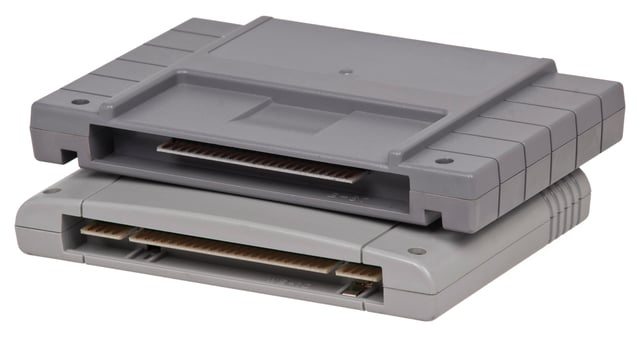
A cartridge shape comparisonTop: North American designBottom: Japanese and PAL region design. The bottom cartridge also illustrates the optional pins used by enhancement chips such as the Super FX 3D chip.
Nintendo employed several types of regional lockout, including both physical and hardware incompatibilities.
On a physical level, the cartridges are shaped differently for different regions. North American cartridges have a rectangular bottom with inset grooves matching protruding tabs in the console, while other regions' cartridges are narrower with a smooth curve on the front and no grooves. The physical incompatibility can be overcome with use of various adapters, or through modification of the console.[77][78]
Internally, a regional lockout chip (CIC) within the console and in each cartridge prevents PAL region games from being played on Japanese or North American consoles and vice versa. The Japanese and North American machines have the same region chip. This can be overcome through the use of adapters, typically by inserting the imported cartridge in one slot and a cartridge with the correct region chip in a second slot. Alternatively, disconnecting one pin of the console's lockout chip will prevent it from locking the console; hardware in later games can detect this situation, so it later became common to install a switch to reconnect the lockout chip as needed.[79]
PAL consoles face another incompatibility when playing out-of-region cartridges: the NTSC video standard specifies video at 60 Hz while PAL operates at 50 Hz, resulting in approximately 16.7% slower framerate. Additionally, PAL's higher resolution results in letterboxing of the output image.[77] Some commercial PAL region releases exhibit this same problem and, therefore, can be played in NTSC systems without issue, while other games will face a 20% speedup if played in an NTSC console. To mostly correct this issue, a switch can be added to place the SNES PPU into a 60 Hz mode supported by most newer PAL televisions. Later games will detect this setting and refuse to run, requiring the switch to be thrown only after the check completes.[80]
Casing
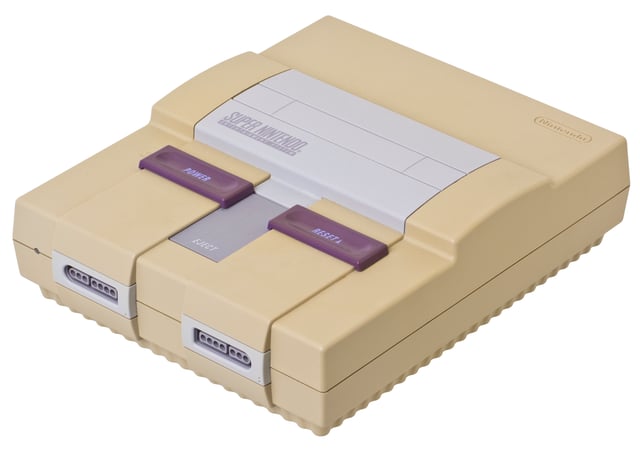
Yellowing of console plastic with age
All versions of the Super NES are predominantly gray, of slightly different shades. The original North American version, designed by Nintendo of America industrial designer Lance Barr[81] (who previously redesigned the Famicom to become the NES[82]), has a boxy design with purple sliding switches and a dark gray eject lever. The loading bay surface is curved, both to invite interaction and to prevent food or drinks from being placed on the console and spilling as had happened with the flat surfaced NES.[81] The Japanese and European versions are more rounded, with darker gray accents and buttons. The North American New-style Super NES (model SNS-101) and the Japanese Super Famicom Jr. (model SHVC-101), all designed by Barr, are both smaller with a rounded contour; however, the SNS-101 buttons are purple where the Super Famicom Jr. buttons are gray. The European and American versions of the SNES controllers have much longer cables compared to the Japanese Super Famicom controllers.
All versions incorporate a top-loading slot for game cartridges, although the shape of the slot differs between regions to match the different shapes of the cartridges. The MULTI OUT connector (later used on the Nintendo 64 and GameCube) can output composite video, S-Video and RGB signals, as well as RF with an external RF modulator.[83][84] Original versions additionally include a 28-pin expansion port under a small cover on the bottom of the unit and a standard RF output with channel selection switch on the back;[85] the redesigned models output composite video only, requiring an external modulator for RF.[86]
The ABS plastic used in the casing of some older SNES and Super Famicom consoles is particularly susceptible to oxidization with exposure to air, likely due to an incorrect mixture of the stabilizing or flame retarding additives. This, along with the particularly light color of the original plastic, causes affected consoles to quickly become yellow; if the sections of the casing came from different batches of plastic, a "two-tone" effect results.[87]
Game cartridge
The cartridge media of the console is officially referred to as Game Pak in most Western regions,[88] and as Cassette (カセット, Kasetto) in Japan and parts of Latin America.[89] While the SNES can address 128 Mbit,[9] only 117.75 Mbit are actually available for cartridge use. A fairly normal mapping could easily address up to 95 Mbit of ROM data (48 Mbit at FastROM speed) with 8 Mbit of battery-backed RAM. However, most available memory access controllers only support mappings of up to 32 Mbit. The largest games released (Tales of Phantasia and Star Ocean) contain 48 Mbit of ROM data,[90][91] while the smallest games contain only 2 Mbit.
Cartridges may also contain battery-backed SRAM to save the game state, extra working RAM, custom coprocessors, or any other hardware that will not exceed the maximum current rating of the console.
Peripherals
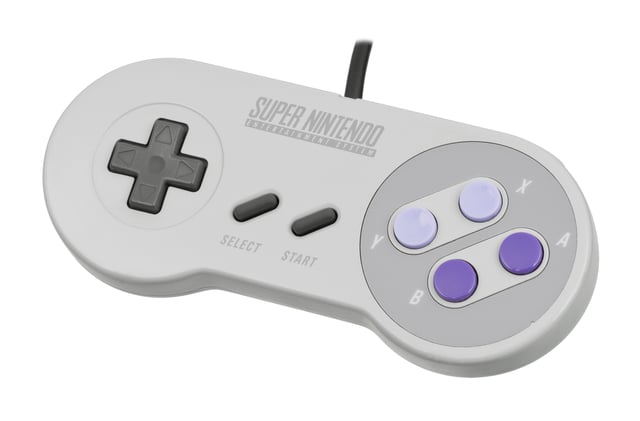
The North American SNES controller
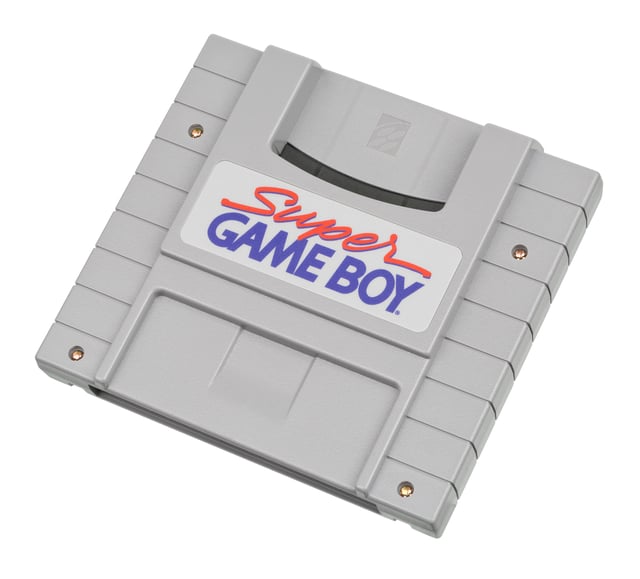
The Super Game Boy allows Game Boy games to be played on the SNES.
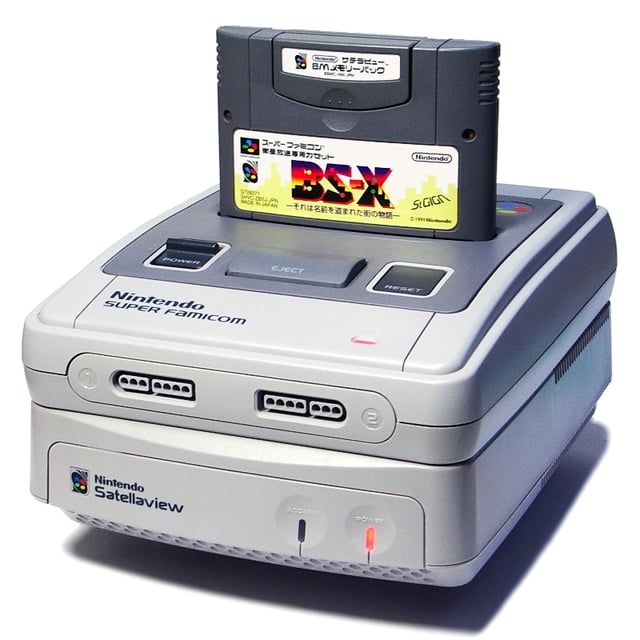
Satellaview with Super Famicom
The standard SNES controller adds X and Y face buttons to the design of the NES iteration, arranging the four in a diamond shape, and adds two shoulder buttons. It features an ergonomic design by Lance Barr, later used for the NES-102 model controllers, also designed by Barr.[81][82] The Japanese and PAL region versions incorporate the colors of the four action buttons into the system's logo. The North American version's buttons are colored to match the redesigned console; the X and Y buttons are lavender with concave faces, and the A and B buttons are purple with convex faces. Several later consoles derive elements of their controller design from the SNES, including the PlayStation, Dreamcast, Xbox, and Wii Classic Controller.[92][93][94]
Throughout the course of its life, a number of peripherals were released which added to the functionality of the SNES. Many of these devices were modeled after earlier add-ons for the NES: the Super Scope is a light gun functionally similar to the NES Zapper (though the Super Scope features wireless capabilities) and the Super Advantage is an arcade-style joystick with adjustable turbo settings akin to the NES Advantage. Nintendo also released the SNES Mouse in conjunction with Mario Paint. Hudson Soft, under license from Nintendo, released the Super Multitap, a multiplayer adapter for use with its popular series of Bomberman games. Some of the more unusual controllers include the BatterUP baseball bat, the Life Fitness Entertainment System (an exercise bike controller with built-in monitoring software),[95] and the TeeV Golf golf club.[96][97]
Though Nintendo never released an adapter for playing NES games on the SNES, the Super Game Boy adapter cartridge allows games designed for Nintendo's portable Game Boy system to be played on the SNES. The Super Game Boy touts several feature enhancements over the Game Boy, including palette substitution, custom screen borders, and access to the SNES console's features by specially enhanced Game Boy games.[98] Japan also saw the release of the Super Game Boy 2, which adds a communication port to enable a second Game Boy to connect for multiplayer games.
Like the NES before it, the SNES has unlicensed third-party peripherals, including a new version of the Game Genie cheat cartridge designed for use with SNES games.
Soon after the release of the SNES, companies began marketing backup devices such as the Super Wildcard, Super Pro Fighter Q, and Game Doctor.[99] These devices create a backup of a cartridge. They can also be used to play illicit ROM images or to create copies of rented video games, violating copyright laws in many jurisdictions.
Japan saw the release of the Satellaview, a modem which attaches to the Super Famicom's expansion port and connected to the St.GIGA satellite radio station from April 23, 1995 to June 30, 2000. Satellaview users could download gaming news and specially designed games, which were frequently either remakes of or sequels to older Famicom games, and released in installments.[100] In the United States, the relatively short-lived XBAND allowed users to connect to a network via a dial-up modem to compete against other players around the country.
During the SNES's life, Nintendo contracted with two different companies to develop a CD-ROM-based peripheral for the console to compete with Sega's CD-ROM based add-on, Sega CD. Although a SNES-CD prototype console was produced by Sony, Nintendo's deals with both Sony and Philips were canceled, with Philips gaining the right to release a series of games based on Nintendo franchises for its CD-i multimedia console and Sony going on to develop its own PlayStation console based on its initial dealings with Nintendo.[101][102]
Enhancement chips
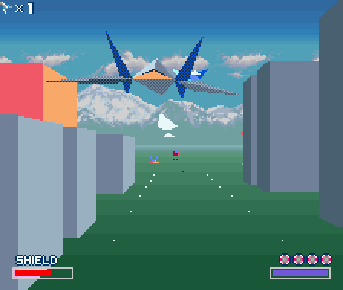
Star Fox, the first game to utilize the Super FX chip, as shown with the polygonal models that compose a large portion of the game's graphics
As part of the overall plan for the SNES, rather than include an expensive CPU that would still become obsolete in a few years, the hardware designers made it easy to interface special coprocessor chips to the console, just like the MMC chips used for most NES games. This is most often characterized by 16 additional pins on the cartridge card edge.[103]
The Super FX is a RISC CPU designed to perform functions that the main CPU can not feasibly do. The chip is primarily used to create 3D game worlds made with polygons, texture mapping and light source shading. The chip can also be used to enhance 2D games.[104]
The Nintendo fixed-point digital signal processor (DSP) chip allowed for fast vector-based calculations, bitmap conversions, both 2D and 3D coordinate transformations, and other functions.[105] Four revisions of the chip exist, each physically identical but with different microcode. The DSP-1 version, including the later 1A and 1B bug fix revisions, is used most often; the DSP-2, DSP-3, and DSP-4 are used in only one game each.[106]
Similar to the 5A22 CPU in the console, the SA-1 chip contains a 65c816 processor core clocked at 10 MHz, a memory mapper, DMA, decompression and bitplane conversion circuitry, several programmable timers, and CIC region lockout functionality.[104]
In Japan, games could be downloaded cheaper than standard cartridges, from Nintendo Power kiosks onto special cartridges containing flash memory and a MegaChips MX15001TFC chip. The chip managed communication with the kiosks to download ROM images, and provided an initial menu to select which of the downloaded games would be played. Some were available both in cartridge and download form, while others were download only. The service closed on February 8, 2007.[107]
Emulation
Like the NES before it, the SNES has retained a long-lived fan base. It has continued to thrive on the second-hand market, emulators, and remakes. The SNES has taken the same revival path as the NES.
Emulation projects began with the initial release of VSMC in 1994, and Super Pasofami became the first working SNES emulator in 1996.[108] During that time, two competing emulation projects—Snes96 and Snes97—merged to form Snes9x.[104] In 1997, SNES enthusiasts began programming an emulator named ZSNES.[109] In 2004, higan began development as bsnes, in an effort to emulate the system as closely as possible.
Nintendo of America took the same stance against the distribution of SNES ROM image files and the use of emulators as it did with the NES, insisting that they represented flagrant software piracy.[110] Proponents of SNES emulation cite discontinued production of the SNES constituting abandonware status, the right of the owner of the respective game to make a personal backup via devices such as the Retrode, space shifting for private use, the desire to develop homebrew games for the system, the frailty of SNES ROM cartridges and consoles, and the lack of certain foreign imports. Nintendo designed a hobbyist development system for the Super NES, but never released it.[111]
Emulation of the Super NES is also available on platforms such as Android,[112] and iOS,[113][114] the Nintendo DS line,[115] the Gizmondo,[116] the Dingoo and the GP2X by GamePark Holdings,[117] as well as PDAs.[118] While individual games have been included with emulators on some GameCube discs, Nintendo's Virtual Console service for the Wii marks the introduction of officially sanctioned general SNES emulation.
A dedicated mini-console, the Super NES Classic Edition, was released in September 2017 after the NES Classic Edition. The emulation-based system, which is physically modeled after the North American and European versions of the SNES in their respective regions, is bundled with two SNES-style controllers and comes preloaded with 21 games, including the previously unreleased Star Fox 2.[119]
Legacy
Approximately 49.1 million Super NES consoles were sold worldwide, with 23.35 million of those units sold in the Americas and 17.17 million in Japan.[14] Although it could not quite repeat the success of the NES, which sold 61.91 million units worldwide,[14] the SNES was the best-selling console of its era.
In 2007, GameTrailers named the SNES as the second-best console of all time in their list of top ten consoles that "left their mark on the history of gaming", citing its graphics, sound, and library of top-quality games.[120] In 2015, they also named it the best Nintendo console of all time, saying, "The list of games we love from this console completely annihilates any other roster from the Big N."[121] Technology columnist Don Reisinger proclaimed "The SNES is the greatest console of all time" in January 2008, citing the quality of the games and the console's dramatic improvement over its predecessor;[122] fellow technology columnist Will Greenwald replied with a more nuanced view, giving the SNES top marks with his heart, the NES with his head, and the PlayStation (for its controller) with his hands.[123] GamingExcellence also gave the SNES first place in 2008, declaring it "simply the most timeless system ever created" with many games that stand the test of time and citing its innovation in controller design, graphics capabilities, and game storytelling.[124] At the same time, GameDaily rated it 5th of the 10 greatest consoles for its graphics, audio, controllers, and games.[125] In 2009, IGN named the Super Nintendo Entertainment System the fourth best video game console, complimenting its audio and number of AAA games.[92]
See also
List of Super Nintendo Entertainment System accessories
Nintendo Selects
